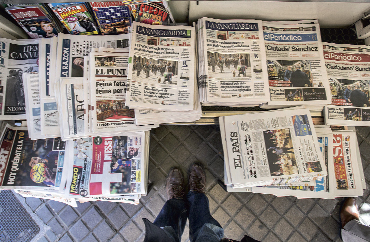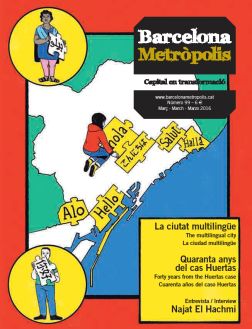There used to be a myth that the centre of “Catalanness” lay in the hills of the Empordà region. I would like to suggest that it is in Barcelona, in any square where children coming home from school might play and chase each other… in Catalan. Where a language that has been so mistreated by history is, in spite of everything, alive and well.

The Catalan- and Spanish-language versions of La Vanguardia and El Periódico side-by-side at a press stand, alongside other, monolingual newspapers, like El Punt Avui (Catalan) or El País (Spanish).
Foto: Pere Virgili.
Catalan has been saved in large part because it was kept alive and is still kept alive in the Catalan metropolis – Barcelona. Maybe it has been kept going in a more hybrid fashion than in inland Catalonia, maybe it is spoken with a neutral vowel that is not as neutral as it used to be, but here it continues to be both the everyday language as well as the language of prestige. No important city in Europe with a medium-sized language like Catalan can say the same: Valencia or Alicante, the rival cities in the Spanish Mediterranean, have had much more influence from the Spanish language, not to mention the cities of the French Midi (Montpellier, Toulouse, Marseille, Nîmes), in old Occitania, where the Occitan language has become a remnant preserved in formaldehyde.
Catalan is a medium-sized language that could aspire to lead a relatively comfortable life, without any hardship, like a retiree with a modest but secure pension. However, in Barcelona, Catalan cannot live peacefully like French does in Paris, Spanish in Madrid, Dutch in Amsterdam or German in Berlin. In all these cities, in addition to the historical language, hundreds of other languages can also be heard thanks to various waves of immigrants, as well as English (which is insidious and inevitable), but there is never any question as to the common language for addressing a stranger on the street. At most, there are conflicts with English, which, as an omnivorous inter-language, encroaches on the functions of the local language or becomes the language of distinction. The western cities that are most comparable with Barcelona are those in which two linguistic groups feel they are the legitimate “owners” of the same territory: English and French in Ottawa/Gatineau in Canada, French and Dutch in Brussels in Belgium, German and Italian in Bolzano/Bolzen in Italy and French and German in Bienne/Biel in Switzerland.
The sociolinguistic situation in Barcelona is fairly chaotic. The in vitro language – the language of the institutions, of the announcements for the next station on underground trains – is often Catalan, while the in vivo language – the more spontaneous language – varies considerably depending on the neighbourhood. The highest concentration of Catalan speakers occurs in the city’s middle and upper middle class neighbourhoods (Gràcia, Guinardó, pockets of Sants and Sant Andreu, Sant Gervasi, etc.), in such a way that socially, Catalan can be labelled the “sandwich” language. On the other hand, people whose first language is Spanish are concentrated in either Pedralbes, Les Corts, Sarrià and Sant Gervasi (Spanish by origin or Hispanicised Catalans) or in working class neighbourhoods such as Nou Barris, El Carmel, La Vall d’Hebron, El Raval, La Verneda, etc. (from the large waves of immigration). El Raval, for example, has changed completely since Joan Amades compiled a record of Catalan folklore, as recounted by its inhabitants, in that neighbourhood in the first half of the 20th century. Now in El Raval, you hear Arabic and Urdu, which have been added to (combined with?) the older layers of Catalan and Spanish. This new population is the result of African, Asian and Latin American migration since the end of the last century. But where do they go linguistically: towards Spanish or towards Catalan? If there is no intervention, the most likely and straightforward option is for them to learn Spanish, the better known language. This equation will also need to take into account the mobile population, particularly tourists and professionals – those who come on cruise ships, low-cost airlines, for medical appointments, for the Mobile World Congress. International globalisation and mobility are added to and interact with a complex sociolinguistic landscape.
A notable exception among European cities
There are thus many Barcelonas, linguistically speaking. The dominance of Spanish in politics and communication is clear: a Spanish state that tends not to be very favourable and a range of media that unreservedly lean towards Spanish, the better-known language. Catalan, however, “holds on” in the city. Barcelona is a very notable exception among European cities: here, a medium-sized and minority language is kept alive, both in the home and in local government. The region’s historical language, Catalan (Spanish is a language that has only taken hold relatively recently), does not have the connotations of “rustic language” that some still claim.
The kaleidoscope of languages in Barcelona is obvious, and almost chaotic. In taxis, for example, when engaging in a bit of small talk en route to the airport, drivers may come across as anti-Catalan, not offering up one word of courtesy in Catalan or, conversely, they may be new learners of Catalan, enthusiastic about the “country that has welcomed us”. Among the Catholic churches we see indecisive priests (God forbid we lose more parishioners…) who hesitate to celebrate mass in either one language or the other. At newspaper stands, the two mountains of copies of the separate editions, in Spanish and Catalan, of La Vanguardia and El Periódico, silently compete with one another. At Camp Nou, the home of Barça, the P.A. announcements are made first in Catalan. At sports centres, many yoga or Pilates classes are advertised in Catalan, but the instructors give them in Spanish. In cinemas, although the information on film times is often in Catalan, the films themselves are dubbed or subtitled in Spanish, except for the miraculous exception of Texas cinema, which screens them in Catalan. In driving schools, the courses are practically always in Spanish, despite the right – purely theoretical – to take the test in Catalan. At the Liceu theatre, the translations of the dialogue that appear under the stage are in Catalan, but the screens in front of each seat are trilingual, in Catalan, Spanish and English. The notices about emergency pharmacies are in Catalan, but all the medications are exclusively in Spanish… At home, in kitchen larders, the products are usually labelled in Spanish (those from Bonpreu and Caprabo stores are two wonderful exceptions), and it is fairly certain that there is more Portuguese present than Catalan. But Catalan is associated with prestigious professions and institutions with appeal (the majority of universities, arts and sports associations, cultural centres of all kinds) and, in particular, with social advancement.
The linguistic competition in the city is therefore unfair, because Spanish is playing with an advantage. But, in spite of it all, this multilingualism works without open conflicts, in the Belgian way, where there are strict borderlines between Dutch and French speakers. There are many new speakers of Catalan; people who have learned it, more or less well, and consider that it is also their language. Maruja Torres, a journalist and writer whose first language is Spanish, learned Catalan in El Raval and writes that Catalan is “a language that will never be like my skin, but without its existence I can’t feel comfortable in my skin” (Maruja Torres (1997: 39) Un calor tan cercano. Madrid: Alfaguara).
We don’t know which directions languages will take in the city. We know for sure that they form and will form part of the identities of Barcelonians. Because languages are not only tools of communication; they also inspire loyalty, they provoke fear, hatred, resentment, jealousy, love, euphoria, an entire range of human emotions. For now I can feel a small sense of pride that, in spite of everything, my city is trying to be both loyal to Catalan – my language, the language of my country – as well as open (but not submissive) to many other languages.



